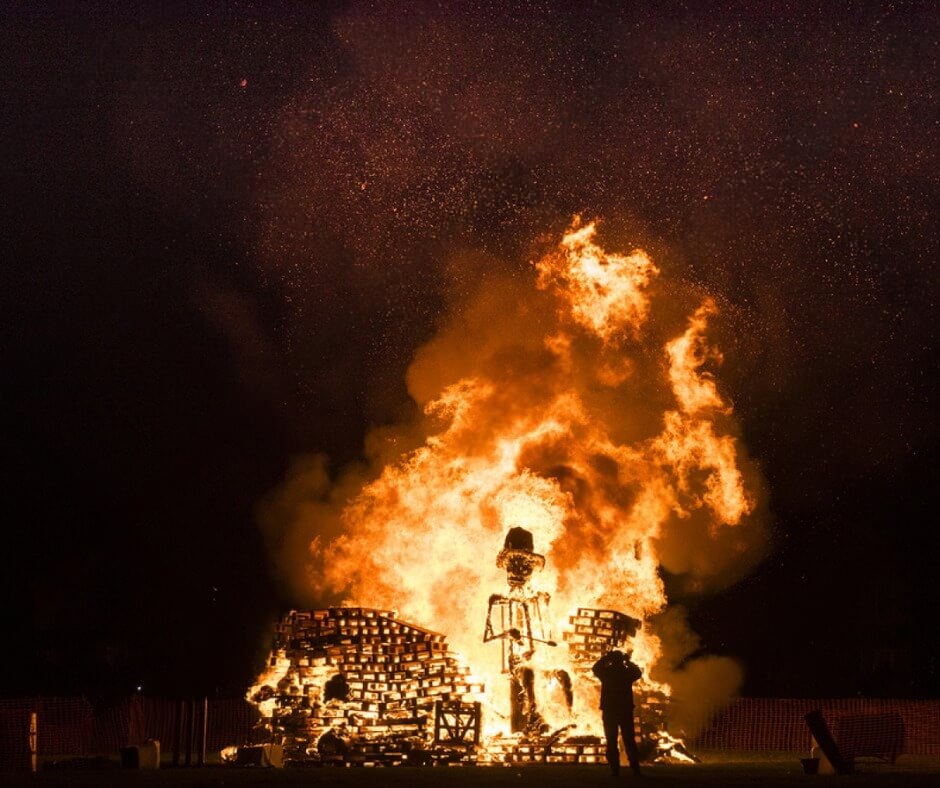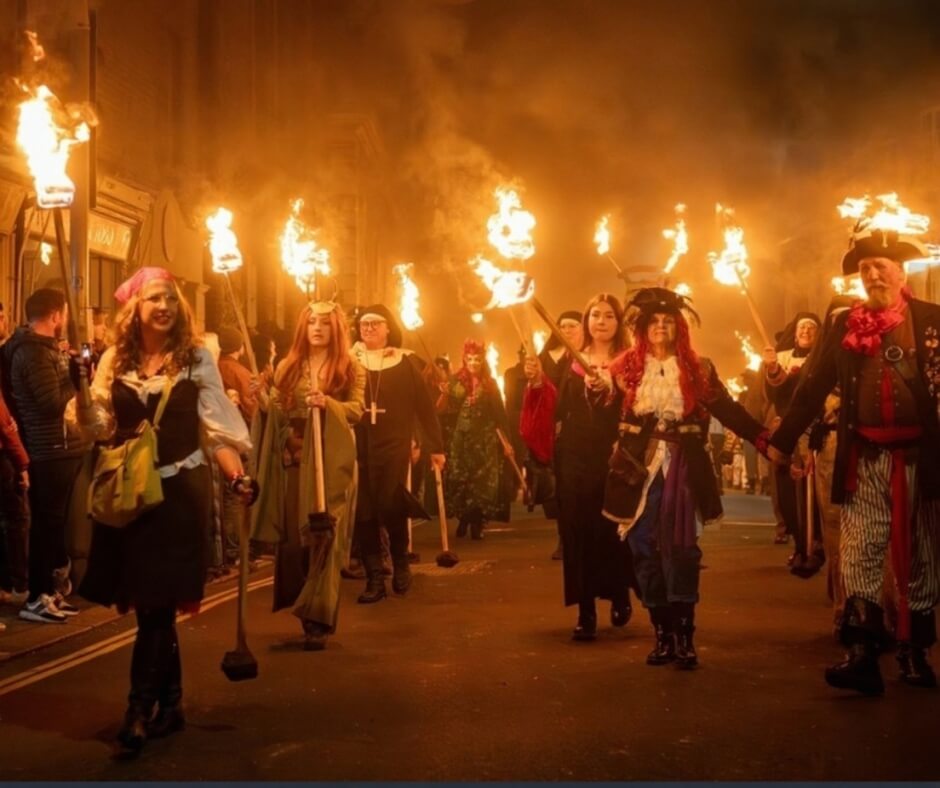“Remember, remember the Fifth of November…”
Each year, as autumn deepens and the air turns crisp, bonfires blaze across England. Fireworks streak through the night sky, children wave sparklers, and the smell of roasted chestnuts and gunpowder fills the air. This is Guy Fawkes Night – a celebration of fire, folklore, and identity that has burned brightly for over four centuries.
But behind the spectacle lies a story of rebellion, faith, and transformation – a story that has helped shape the character of England itself.
The Gunpowder Plot: A Nation on the Brink
The origins of Guy Fawkes Night trace back to 1605, a time of religious tension in England. After years of persecution under Protestant monarchs, many English Catholics had hoped that the new king, James I, would bring tolerance. Instead, restrictions on their worship continued, deepening resentment and despair.
Out of this turmoil emerged a group of thirteen conspirators, led by Robert Catesby, who plotted to blow up the Houses of Parliament during the State Opening on November 5th, when the king and his government would be present. Their goal: to ignite a rebellion and restore a Catholic monarch to the throne.
To carry out the plan, the conspirators rented a cellar beneath Parliament and stockpiled 36 barrels of gunpowder – enough to level Westminster. Standing guard over the deadly cargo was Guy Fawkes, a soldier and explosives expert who had fought for Catholic Spain.
But on the night before the attack, the plan unraveled. A mysterious letter warning a Catholic lord to stay away reached the authorities. In the early hours of November 5th, soldiers discovered Fawkes with matches and fuses in hand. Tortured in the Tower of London, he revealed the names of his fellow plotters, all of whom were hunted down and executed.
The Gunpowder Plot had failed – but its echoes would last for centuries.

From Treason to Tradition
News of the failed plot spread quickly, and the people of London celebrated the king’s survival by lighting bonfires. Within months, Parliament declared November 5th a national day of thanksgiving – the Observance of 5th November Act (1606) – calling for church services and expressions of loyalty to the Crown.
What began as political propaganda soon evolved into popular festivity. Communities began holding torchlight processions, burning effigies of the pope or Guy Fawkes himself. Children paraded straw-stuffed “Guys” through the streets, shouting “A penny for the Guy!” and collecting coins for fireworks.
By the 18th and 19th centuries, Bonfire Night had become a beloved folk event, marked by firework displays, fairs, and feasts of baked potatoes and toffee apples. In some towns, rival gangs staged “bonfire battles,” each trying to outdo the other’s pyrotechnic displays.
The religious undertones gradually faded, and the holiday transformed into something quintessentially English: a celebration of community, resilience, and the fiery joy of gathering under the autumn sky.

Fire, Folklore, and the English Spirit
Fire has always held a deep symbolic power in English culture – from the hearths of medieval cottages to the beacons lit along the coast in times of war. On Guy Fawkes Night, it became a way to express both defiance and unity.
The bonfire represents purification – a burning away of fear and division – but it also embodies rebellion. The image of flames consuming the “Guy” reminds England of its turbulent past, of the fine line between faith and fanaticism, authority and dissent.
For centuries, the celebration has also served as a mirror of English identity. The refrain “Remember, remember the Fifth of November” is more than a warning; it is a cultural mantra about vigilance and freedom. The figure of Guy Fawkes, once reviled as a traitor, has even evolved into a symbol of resistance. In modern times, the stylized mask from V for Vendetta has been adopted by activists and protest movements worldwide – a striking reminder of how deeply this story resonates.

Modern-Day Celebrations
Today, Guy Fawkes Night remains one of Britain’s most atmospheric celebrations. Across the country, villages and cities light bonfires and host dazzling fireworks displays.
- Lewes, in Sussex, is famous for its grand parades, where costumed “bonfire societies” carry flaming torches through the narrow streets, accompanied by drummers and banners.
- In Ottery St. Mary in Devon, locals carry enormous flaming barrels through the town – a thrilling and dangerous tradition dating back centuries.
- In London, large-scale displays take place in Battersea Park, Alexandra Palace, and Blackheath, drawing crowds of thousands.
Families gather to share parkin cake (a sticky gingerbread from Yorkshire), bonfire toffee, and hot cider. Children still chant rhymes about Guy Fawkes, while fireworks illuminate the November darkness with a spectacle that feels both ancient and modern.
The tone has softened – no longer about treason or punishment, but about warmth, nostalgia, and the joy of shared tradition. Guy Fawkes Night, like the nation it celebrates, has reinvented itself over time while holding fast to its roots.

A Reflection of National Memory
Every year, as sparks rise into the cold November air, Guy Fawkes Night invites reflection on the contradictions of English history – rebellion and loyalty, faith and freedom, fear and festivity.
It reminds the nation of how close it once came to chaos, yet how powerfully it transformed that danger into identity. The story of Guy Fawkes is not simply one of failure; it is the story of a country learning to define itself through its own myths, rituals, and reinventions.
In the glow of the bonfire, communities across England connect not only with each other, but with four hundred years of living tradition.
Stay Amidst England’s Heritage: The Great Inns of Britain
To experience England’s spirit beyond the fireworks, stay in one of The Great Inns of Britain – our distinguished member hotels across the country. These historic inns and manor houses offer not just comfort, but a deep connection to English heritage.
Whether you choose a centuries-old coaching inn in the Cotswolds, a country house by the Yorkshire moors, or a seaside retreat in Cornwall, each property tells its own story through warm hospitality, local cuisine, and authentic character.
Discover the charm of traditional England and plan your stay at The Great Inns of Britain.

